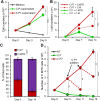IL-7 armed binary CAR T cell strategy to augment potency against solid tumors
- PMID: 40808942
- PMCID: PMC12343627
- DOI: 10.3389/fimmu.2025.1618404
IL-7 armed binary CAR T cell strategy to augment potency against solid tumors
Abstract
Introduction: Clinical studies of T cells engineered with chimeric antigen receptor (CAR) targeting CD19 in B-cell malignancies have demonstrated that relapse due to target antigen (CD19) loss or limited CAR T cell persistence is a common occurrence. The possibility of such events is greater in solid tumors, which typically display more heterogeneous antigen expression patterns and are known to directly suppress effector cell proliferation and persistence. T cell engineering strategies to overcome these barriers are being explored. However, strategies to simultaneously address both antigen heterogeneity and T cell longevity, while localizing anti-tumor effects at disease sites, remain limited.
Methods: In this study we explore a dual antigen targeting strategy by directing independent CARs against the solid tumor targets PSCA and MUC1. To enhance functional persistence in a tumor-localized manner, we expressed the transgenic IL-7 cytokine and receptor (IL-7Rα) in respective CAR products.
Results: This binary strategy, which incorporates dual antigen targeting with transgenic cytokine support, resulted in enhanced potency, T cell expansion, and durable antitumor effects in a pancreatic tumor model compared to single antigen targeting or dual antigen targeting in absence of the transgenic cytokine support.
Discussion: The transgenic IL-7 armed binary CAR T cell approach could improve the efficacy of CAR-based therapies for solid tumors.
Keywords: IL-7; IL-7R; MUC 1; PSCA; T-cell therapy; chimeric antigen receptor; pancreatic cancer; solid tumor.
Copyright © 2025 Torres Chavez, McKenna, Gupta, Daga, Vera, Leen and Bajgain.
Conflict of interest statement
AL is a co-founder and equity holder for AlloVir and Marker Therapeutics, and was a consultant to AlloVir. JV is the chief executive officer, a co-founder, and equity holder of Marker Therapeutics. The remaining authors declare that the research was conducted in the absence of any commercial or financial relationships that could be construed as a potential conflict of interest.
Figures





Update of
-
IL-7 armed binary CAR T cell strategy to augment potency against solid tumors.bioRxiv [Preprint]. 2025 Jun 27:2025.06.25.661524. doi: 10.1101/2025.06.25.661524. bioRxiv. 2025. Update in: Front Immunol. 2025 Jul 30;16:1618404. doi: 10.3389/fimmu.2025.1618404. PMID: 40667190 Free PMC article. Updated. Preprint.
References
MeSH terms
Substances
Grants and funding
LinkOut - more resources
Full Text Sources
Medical
Research Materials
Miscellaneous

